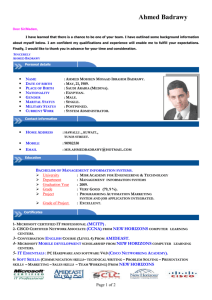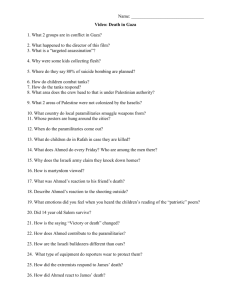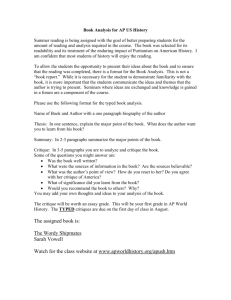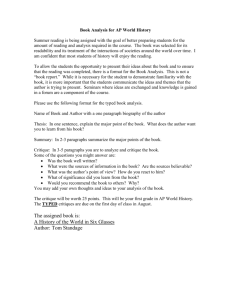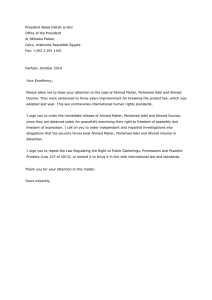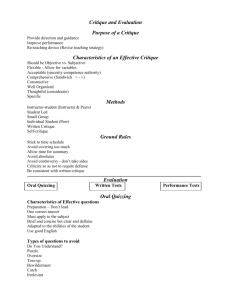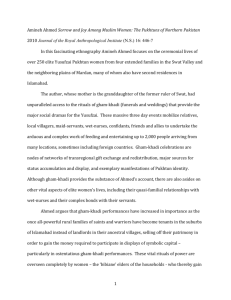Can critical thinking and sexism co-exist?
advertisement
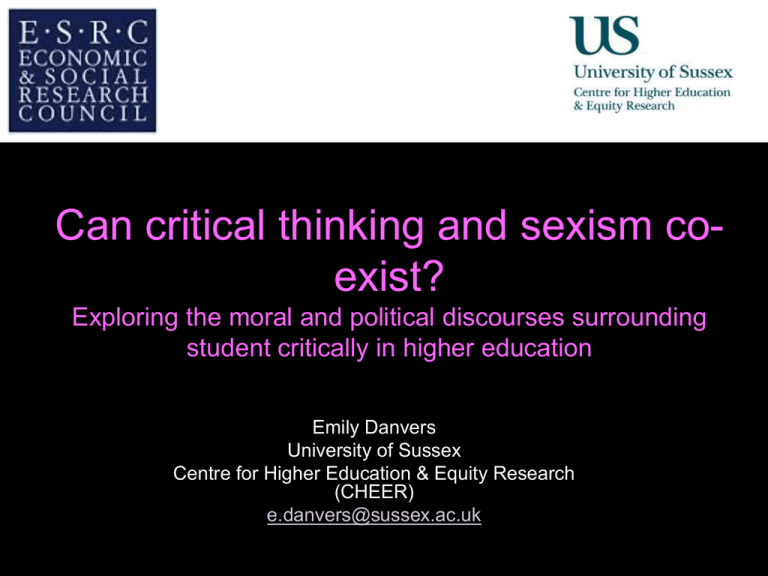
Diversity, Democratisation and Difference: Theories and Methodologies Can critical thinking and sexism coexist? Exploring the moral and political discourses surrounding student critically in higher education Emily Danvers University of Sussex Centre for Higher Education & Equity Research (CHEER) e.danvers@sussex.ac.uk Provocations – critical thinking and sexism • What can accounts of academic sexism(e.g. lad cultures1) tell us about the ‘critical’ space of higher education? ALSO • Is criticality always counterhegemonic/always about the ‘other’? • How does critical thinking interact with ugly feelings of disagreement, dislike and distance? 1 Phipps and Young, 2013 Feminist/new materialist critical thinking • Research with 1st year UK social science students (15 interviews, a focus group, 3 month classroom observations). Following around critical thinking, interrogating how it is conceptualised, embodied and regulated • Using Sara Ahmed’s (2010, 2013) work to help me negotiate critical thinking’s affective territories/consequences • Using Karen Barad’s (2007) work to think beyond critical thinking as a textual discourse to its material interactions with people and place • Reading the space between these two theorists to explore forms of feminist critical thinking that address inequality both in the abstract and the everyday For example, debates on critique • Barad (2012) claims that because critique has become ‘a practice of negativity…distancing and othering’ her students can ‘spit out a critique with the push of a button’ • Ahmed (2014) ‘I doubt very much that critiquing whiteness is something students have learnt to spit out. In fact, much of what needs critiquing still seems to go unnoticed in our academic worlds’. Complex (and contradictory) locations Rationality ‘I’ve basically finished…I’ve just got to put the critical bit in…but we’ve only got 200 words for that’ Contextual/ embodied ‘If you get too critical of everything…you’ll get a bit paranoid or grumpy. So you have to be careful not to just assume the worst in everything. To think about it, to not just let it consume you.’ Can you be a critical thinker and be sexist? Some Possible responses: • • • • • • • We all choose what we think critically about Aren’t we all entitled to disagree? We can’t always be critical of everything It’s a joke - that’s not how I really think Of course I’m a critical thinker, I’m an academic Criticality is about pedagogy not politics Critical thinking is difficult/negative Superiority of highly educated other ‘You are at university. You’d liked to think that people are fairly informed and you know, bright enough to think, well that kind of thing is not acceptable’. (Bronwyn, professional cohort, focus group discussion) • The (uninformed) critical thinking sexist can be educated to think differently –creates privileged intellectual capital • Critical thinking becomes a non-performative (Ahmed, 2012), a discursive stand-in amongst a community that feels it already is critical Neo-liberal critical thinking Moment of a protest interrupting a lesson on critical thinking – cerebral vs. lived activism • Evans (2004) neo-liberal higher education is ‘killing thinking’ by fostering anti-intellectual and anti-democratic cultures • Critical thinking becoming instrumentalised – as part of a purification ritual of work on the self – linked to commodification and consumerism – certain forms of criticality are the norm (assessment) others are more transgressive (protest) Resistance at level of affect ‘You can do it as a choice …you can think about anything critically if you wanted to but sometimes people might think it's too much effort to think through, it might bring up bad emotions…Like child poverty in Africa, if you started thinking about that all the time it'd be awful’ (Jodie, professional cohort, interview) • Affective tightrope between criticality and sociability’– fear of being a feminist killjoy (Ahmed, 2010) • Critical thinking appearing unarticulated at the level of affect, through such ‘ugly feelings’ (Ngai, 2011) Conclusions • Unpacking the discourse of critical thinking to look at the affective and contextual (as well as the cognitive) helps us explore what critique is and should be for • An embodied, power-sensitive approach to critique (though imperfect and partial) would problematise whether criticality and sexism can (and should) co-exist in ways more rationalist approaches would not. References • • • • • • • • Ahmed, S. (2010). The Promise of Happiness. North Carolina, USA: Duke University Press. Ahmed, S. (2012). On being included: racism and diversity in institutional life. Durham, USA & London: Duke University Press. Ahmed, S., (2014) Feminist Critique [online]. http://feministkilljoys.com/2014/05/26/feministcritique/ [Accessed 26.08.14] Barad, K. (2007). Meeting the Universe Halfway: Quantum Physics and the Entanglement of Matter. North Carolina, USA: Duke University Press. Barad, K., (2012) Matter feels, converses, suffers, desires, yearns and remembers: Interview with Karen Barad. In R. Dolphijn & I. Van Der Tuin (eds). New Materialism: Interviews & Cartographies. University of Michigan: Open Humanities Press [online]. http://quod.lib.umich.edu/o/ohp/11515701.0001.001/1:4.3/--new-materialism-interviewscartographies?rgn=div2;view=fulltext [Accessed 26.08.14] Evans, M. (2004) Killing Thinking: The Death of the University. London: Continuum. Ngai, S. & Jasper, A. (2011) Our Aesthetic Categories: An Interview with Sianne Ngai. Forensics, 43. [online] http://www.cabinetmagazine.org/issues/43/jasper_ngai.php [Accessed 26.08.14]\ Phipps, A. & Young, I. (2013) That's what she said: women students' experiences of 'lad culture' in higher education. London: National Union of Students.
![Re-thinking critical thinking in higher education: DANVERS [PPT 988.50KB]](http://s2.studylib.net/store/data/014998805_1-82f74c4aa603e2ff7c63eaaacd975914-300x300.png)
